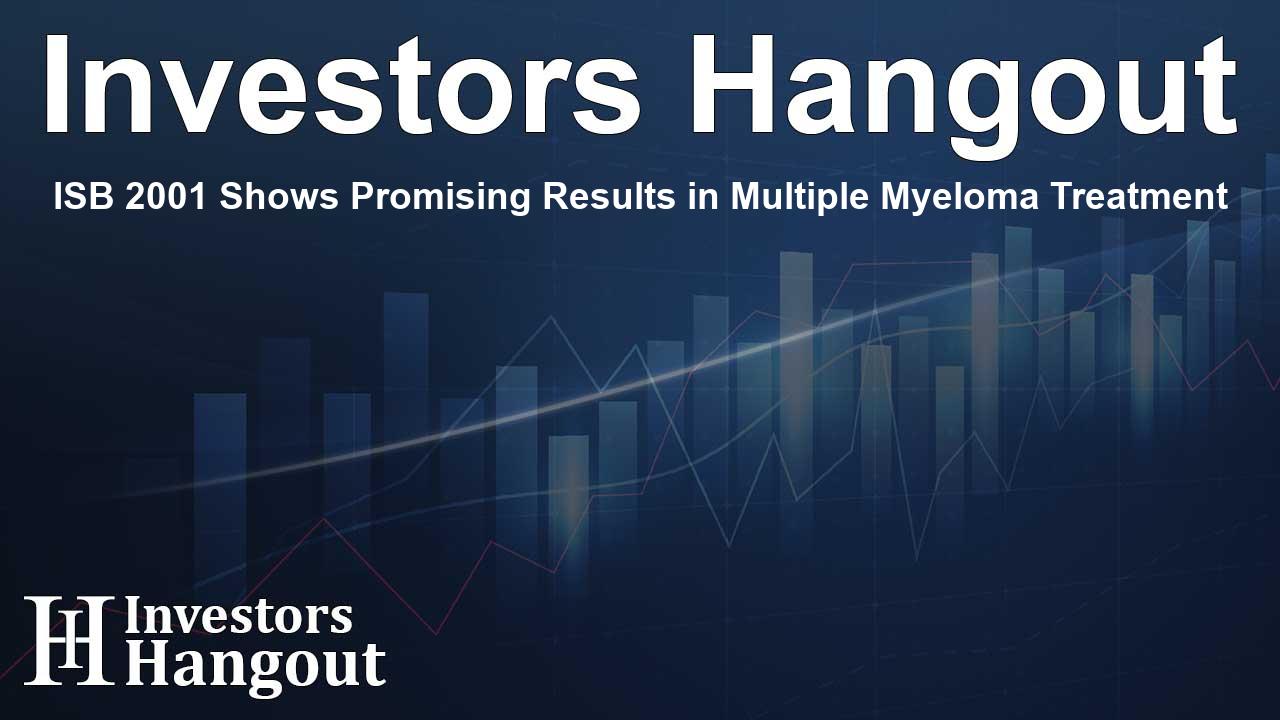ISB 2001 Shows Promising Results in Multiple Myeloma Treatment

Breakthrough Data on ISB 2001 in Multiple Myeloma Treatment
The latest findings from the TRIgnite-1 study have unveiled impressive outcomes for ISB 2001, a pioneering trispecific antibody targeting BCMA, CD38, and CD3 in patients suffering from relapsed or refractory multiple myeloma (RRMM). This investigational therapy has demonstrated a significant overall response rate (ORR) of 74% across various dose levels involving heavily pretreated subjects, each having undergone an average of six prior therapies. This remarkable achievement highlights the potential of ISB 2001 as an innovative treatment option.
Outstanding Response Rates in Diverse Patient Profiles
ISB 2001 exhibited an extraordinary ORR of 84% in patients who had not previously received CAR-T or bispecific therapies. Even for individuals who were previously treated with targeted therapies, ISB 2001 yielded an ORR ranging from 71% to 73%. These statistics portray the efficacy of ISB 2001, particularly in individuals deemed difficult to treat. Furthermore, the ongoing favorable safety profile of this medication has allowed a majority of patients to remain on treatment up to the latest data cutoff.
Regulatory Recognition and Study Progress
In recognition of its potential, the FDA granted ISB 2001 a Fast Track Designation, expediting its path through the regulatory process. As part of the Phase 1 TRIgnite-1 study, results were shared during the recent American Society of Clinical Oncology (ASCO) Annual Meeting, reinforcing the promising advancements in treating RRMM populations. The encouraging data showcased a high complete and stringent complete response (CR/sCR) rate of 30% across the seven active dose levels, highlighting ISB 2001's capacity to deliver substantial therapeutic effects.
Emerging Insights from Clinical Findings
The TRIgnite-1 study involved 35 participants, with results consistently reinforcing ISB 2001's strong performance. The majority, having undergone a median of six therapies prior to inclusion, report substantial improvements. Specifically, of the 33 patients treated at or above 50 µg/kg, the sustained ORR was documented at 79%, supported by a median follow-up period of six months.
Long-Term Efficacy and Safety Profile
Notable results indicated that among the 10 patients achieving CR/sCR, six attained minimal residual disease (MRD) negativity, confirming the treatment's potency. In a separate analysis, 25 patients who were refractory to anti-CD38 therapies had a respectable ORR of 72%, while a noteworthy 32% of non-T cell-directed therapy recipients saw similar or better outcomes.
Management of Side Effects
Patient safety remains a focal point with ISB 2001 demonstrating a commendable safety profile throughout the escalation phases. Observed side effects, although not negligible, were primarily mild and included cytokine release syndrome in 69% of cases, mitigating concerns regarding treatment-related severe complications. Importantly, there were no reported instances of dose-limiting toxicities, underscoring ISB 2001's therapeutic potential with manageable side effects.
Continued Research and Future Directions
The dose-expansion segment of the Phase 1 study aims to identify the recommended Phase 2 dose (RP2D) and clarify the optimal dosing schedule as IGI progresses with ISB 2001. Plans are set to evaluate in a broader pool of RRMM patients to further ascertain treatment capabilities and safety levels in more diverse demographics. The focus on defining these parameters reflects a determined effort to navigate towards the initial registrational study essential for bringing ISB 2001 to those in need.
About ISB 2001 and Clinical Development
As a first-in-class trispecific T-cell engager, ISB 2001 is strategically developed through IGI's proprietary BEAT® protein platform. This design enables enhanced efficacy by targeting myeloma-associated antigens with minimal off-target toxicity, setting a new standard in treatment paradigms for RRMM. The recognition of ISB 2001 comes during an era when treatment options for this population remain significantly limited.
Frequently Asked Questions
What is ISB 2001?
ISB 2001 is an investigational trispecific antibody targeting specific proteins on myeloma cells, aimed at treating relapsed/refractory multiple myeloma.
What were the response rates observed in the TRIgnite-1 study?
The study indicated an overall response rate of 74%, with higher rates noted in patients who had not previously undergone CAR-T or bispecific therapies.
How does ISB 2001's safety profile compare to other treatments?
ISB 2001 maintains a favorable safety profile, with most side effects being manageable and not severe, unlike many traditional therapies.
What is the future outlook for ISB 2001?
IGI is progressing with a broader patient evaluation to define optimal dosing and advance toward the registrational study for ISB 2001.
What is the significance of the Fast Track Designation?
This designation by the FDA aims to expedite the development and review processes for promising treatments, enhancing ISB 2001’s potential availability for patients.
About The Author
Contact Owen Jenkins privately here. Or send an email with ATTN: Owen Jenkins as the subject to contact@investorshangout.com.
About Investors Hangout
Investors Hangout is a leading online stock forum for financial discussion and learning, offering a wide range of free tools and resources. It draws in traders of all levels, who exchange market knowledge, investigate trading tactics, and keep an eye on industry developments in real time. Featuring financial articles, stock message boards, quotes, charts, company profiles, and live news updates. Through cooperative learning and a wealth of informational resources, it helps users from novices creating their first portfolios to experts honing their techniques. Join Investors Hangout today: https://investorshangout.com/
The content of this article is based on factual, publicly available information and does not represent legal, financial, or investment advice. Investors Hangout does not offer financial advice, and the author is not a licensed financial advisor. Consult a qualified advisor before making any financial or investment decisions based on this article. This article should not be considered advice to purchase, sell, or hold any securities or other investments. If any of the material provided here is inaccurate, please contact us for corrections.
